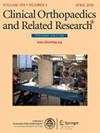Does Valgus Bracing Reduce Estimates of Medial Tibial, Medial Femoral, and Patella Cartilage Contact Pressure in Varus Malaligned Medial Knee Osteoarthritis?
IF 4.2
2区 医学
Q1 ORTHOPEDICS
引用次数: 0
Abstract
BACKGROUND Valgus bracing may be particularly effective for the management of varus malaligned medial knee osteoarthritis (OA). Among several potential mechanisms, valgus bracing may impart clinical benefit by reducing medial tibiofemoral joint contact force. However, prior research shows a tenuous effect of valgus bracing on medial tibiofemoral joint contact force. Tissue-level knee mechanics, such as the magnitude and location of cartilage pressure, may provide important insights into potential mechanisms but remain underinvestigated. QUESTIONS/PURPOSES (1) Does valgus bracing reduce estimates of medial tibial, medial femoral, and patella cartilage contact pressure during walking compared with unbraced walking in patients with varus malaligned medial knee OA? (2) Are there changes in the region of cartilage pressure upon the medial tibia, medial femoral condyle, and patella between braced and unbraced walking? METHODS Baseline data from 28 clinical trial participants with varus malalignment and knee OA walking braced and unbraced were used. Volunteers were recruited from the community in Melbourne, Australia between April 2019 and November 2019. Major inclusion criteria included having radiographic tibiofemoral joint OA and varus malalignment, age ≥ 50 years, and current and > 3-month history of knee pain. Because of incomplete MRI data (n = 3), 25 of the original 28 participants were included in this secondary analysis. The cohort had a mean ± SD age of 64 ± 5 years, BMI of 29.4 ± 3.1 kg/m2, and more males (n = 14) than females (n = 11). A validated 12 degrees of freedom knee model with MRI-derived cartilage morphology and ligament insertion points was combined with a calibrated EMG-informed neuromusculoskeletal model to simulate knee contact mechanics. Tibiofemoral and patellofemoral cartilage contact simulations were performed across the stance phase of walking for four braced and unbraced trials using a nonlinear elastic foundation contact model. Outcomes addressing our first study question were estimates of maximum and mean medial tibial, medial femoral, and patella cartilage contact pressure (in megapascals [MPa]). Outcomes addressing our second study question were change in center of pressure from heel strike in the anatomic medial-lateral direction (normalized to % of cartilage width) and AP direction (normalized to % of cartilage length). Primary statistical analysis was statistical parametric mapping using one-way repeated-measures ANOVA models, which evaluate time-varying differences across stance. The point in stance with the largest differences was reported as mean difference and 95% confidence interval (CI). RESULTS Braced walking had a lower maximum medial tibial cartilage contact pressure compared with unbraced walking during 7% to 15%, 26% to 40%, and 65% to 90% of stance, with the largest difference at 87% of stance (mean ± SD unbraced 16.0 ± 4.3 MPa, braced 14.0 ± 3.6 MPa, mean difference -2.0 MPa [95% CI -3.5 to -0.6]; p < 0.001) (12.5% change). Reductions in cartilage pressures during braced walking were of similar magnitudes and occurred at similar regions of stance for mean tibial and maximum/mean femoral cartilage contact pressure, with no differences in patella cartilage contact pressure. Compared with unbraced, braced walking had a center of pressure located more lateral on the medial tibia cartilage during 0% to 54% of stance and more posterior during 0% to 12% of stance, with the largest difference occurring at 4% of stance (unbraced -0.8% ± 2.1%, braced 3.6% ± 3.8%, mean difference 4.4% [95% CI 1.9% to 6.8%]; p < 0.001) and 5% of stance (unbraced -5.0% ± 2.9%, braced -3.0% ± 3.5%, mean difference 2.0% [95% CI 0.2% to 3.8%]; p < 0.003), respectively. Upon the medial femur cartilage, center of pressure was more laterally located during braced walking compared with unbraced, but showed no differences in the AP direction. No differences in center of pressure were found upon the patella cartilage. CONCLUSION Valgus bracing reduced the magnitude of medial tibiofemoral cartilage contact pressure in patients with varus malaligned knee OA, which may be a mechanism underpinning the reported clinical benefit of valgus bracing. Further investigation is needed to explore whether shifting the location of loading away from potential sources of pain has clinical relevance. CLINICAL RELEVANCE Our study found valgus bracing to reduce knee cartilage pressure during certain stance regions, which may help to improve brace design and thus patient care in knee OA. Future clinical trials should examine whether brace-induced changes to cartilage pressure create meaningful benefit to the patient. Such knowledge will help clinicians make informed decisions about which patients may benefit most from a valgus bracing intervention.外翻支具能降低内翻不正位膝内侧骨关节炎患者胫骨内侧、股骨内侧和髌骨软骨接触压力的估计值吗?
背景外翻支具可能对内翻不正膝关节内侧骨关节炎(OA)的治疗特别有效。在几种可能的机制中,外翻支具可能通过减少内侧胫股关节接触力而赋予临床益处。然而,先前的研究表明外翻支具对内侧胫股关节接触力的影响微弱。组织水平的膝关节力学,如软骨压力的大小和位置,可能为潜在的机制提供重要的见解,但仍有待研究。问题/目的(1)外翻支具是否降低了内翻不正膝OA患者行走时胫骨内侧、股骨内侧和髌骨软骨接触压力的估计?(2)有支架和无支架行走时,胫骨内侧、股骨内侧髁和髌骨的软骨受压区域是否有变化?方法:采用28例内翻畸形和膝关节OA患者的基线数据,分别采用支架和非支架。志愿者是在2019年4月至2019年11月期间从澳大利亚墨尔本的社区招募的。主要入选标准包括有胫骨股骨关节骨性关节炎和内翻错位,年龄≥50岁,当前和未来3个月的膝关节疼痛史。由于MRI数据不完整(n = 3),最初的28名参与者中有25人被纳入了这次二次分析。该队列的平均±SD年龄为64±5岁,BMI为29.4±3.1 kg/m2,男性(n = 14)多于女性(n = 11)。将经过验证的具有mri衍生软骨形态和韧带插入点的12自由度膝关节模型与校准的肌电信息神经肌肉骨骼模型相结合,以模拟膝关节接触力学。采用非线性弹性基础接触模型,在行走的站立阶段进行了四次有支架和无支架试验的胫股软骨和髌股软骨接触模拟。解决我们第一个研究问题的结果是估计胫骨内侧、股骨内侧和髌骨软骨接触压力的最大值和平均值(以兆帕斯卡为单位[MPa])。解决我们的第二个研究问题的结果是,在解剖的中外侧方向(归一化到软骨宽度的%)和AP方向(归一化到软骨长度的%),脚跟撞击造成的压力中心的变化。主要统计分析是使用单向重复测量方差分析模型进行统计参数映射,该模型评估了不同姿态之间的时变差异。差异最大的位置点报告为平均差异和95%置信区间(CI)。结果在7% ~ 15%、26% ~ 40%和65% ~ 90%的站立状态下,带支架行走与不带支架行走相比,胫骨内侧软骨最大接触压力较低,差异最大的为87%(平均值±SD无支架行走16.0±4.3 MPa,带支架行走14.0±3.6 MPa,平均值差-2.0 MPa [95% CI -3.5 ~ -0.6];P < 0.001)(变化12.5%)。在支撑行走期间,软骨压力的减少幅度相似,发生在胫骨和股骨软骨平均接触压力和最大/平均接触压力相似的站立区域,髌骨软骨接触压力没有差异。与不带支架行走相比,在0% ~ 54%的站立时,带支架行走的压力中心更外侧位于胫骨内侧软骨,在0% ~ 12%的站立时,压力中心更后侧位于胫骨内侧软骨,其中最大的差异发生在4%的站立时(未带支架-0.8%±2.1%,带支架3.6%±3.8%,平均差异4.4% [95% CI 1.9% ~ 6.8%];p < 0.001)和5%的站立(未支架-5.0%±2.9%,支架-3.0%±3.5%,平均差2.0% [95% CI 0.2% ~ 3.8%];P < 0.003)。在内侧股骨软骨上,与不带支架行走相比,带支架行走时压力中心更偏向外侧,但在AP方向上没有差异。髌骨软骨受压中心未见差异。结论外翻支具降低了膝关节内翻畸形OA患者胫股内侧软骨接触压力的大小,这可能是外翻支具临床疗效的机制之一。需要进一步的研究来探讨是否转移负荷的位置远离潜在的疼痛源具有临床意义。临床意义我们的研究发现外翻支具在某些姿势区域可以减少膝关节软骨的压力,这可能有助于改善支具的设计,从而改善膝关节OA患者的护理。未来的临床试验应该检查支架引起的软骨压力改变是否对患者有意义的益处。这些知识将有助于临床医生做出明智的决定,哪些患者可能从外翻支具干预中获益最多。
本文章由计算机程序翻译,如有差异,请以英文原文为准。
求助全文
约1分钟内获得全文
求助全文
来源期刊
CiteScore
7.00
自引率
11.90%
发文量
722
审稿时长
2.5 months
期刊介绍:
Clinical Orthopaedics and Related Research® is a leading peer-reviewed journal devoted to the dissemination of new and important orthopaedic knowledge.
CORR® brings readers the latest clinical and basic research, along with columns, commentaries, and interviews with authors.

 求助内容:
求助内容: 应助结果提醒方式:
应助结果提醒方式:


